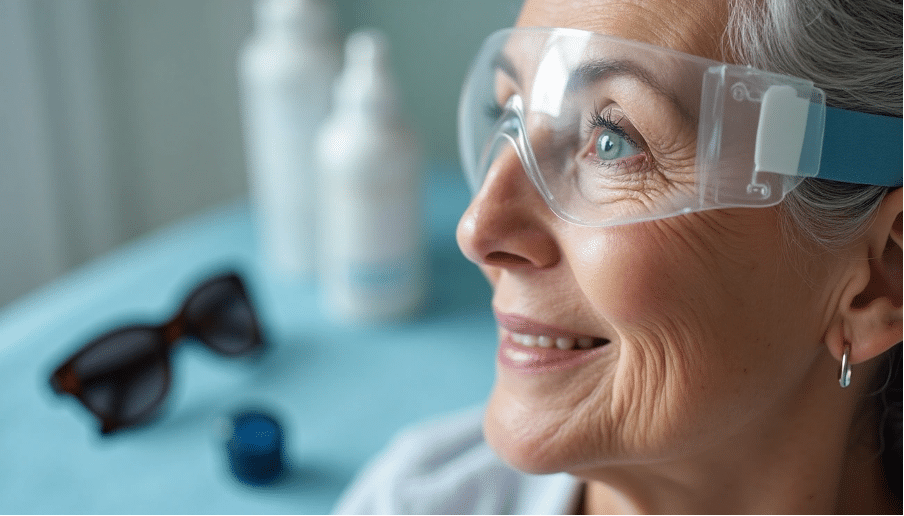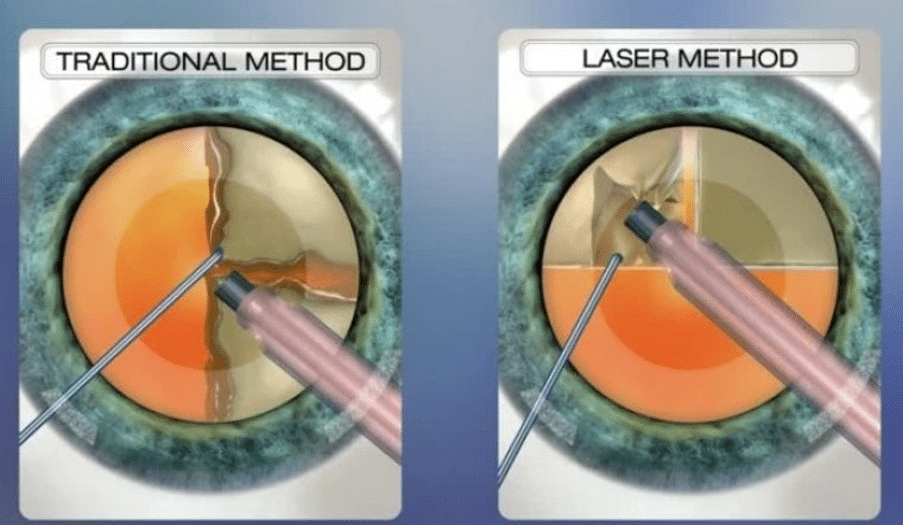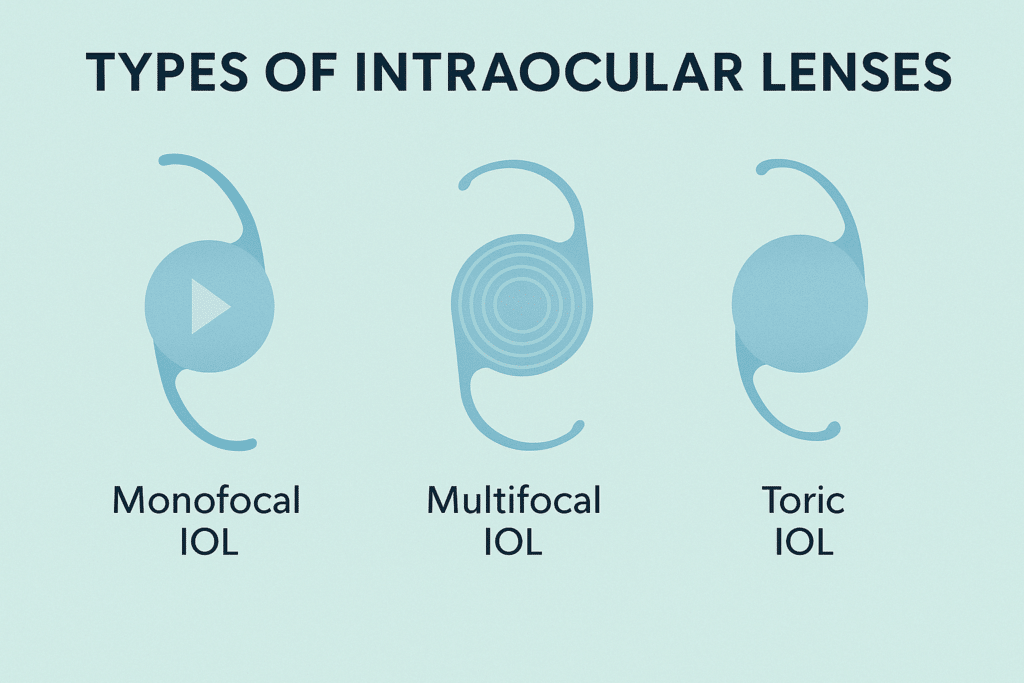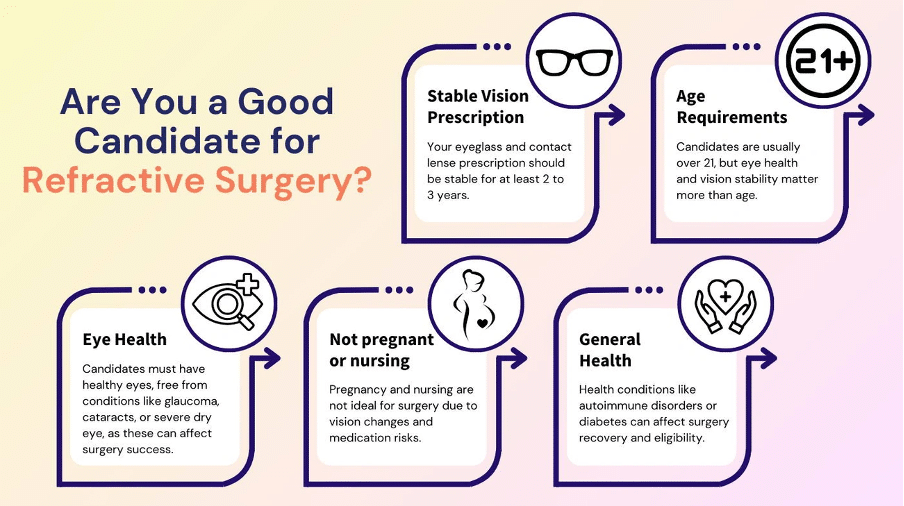Refractive cataract surgery produces amazing results. Patient satisfaction rates reach about 95%. The latest multifocal intraocular lenses (IOLs) help four out of five patients live completely glasses-free after their procedure.
Many prospective patients struggle to grasp the key differences between standard and refractive cataract surgery. The number of cataract operations has jumped 3.7 times since 1989, with a 50% increase since 1999. UK patients looking at private cataract surgery costs will notice substantial price differences. Standard procedures cost around £2,700 per eye, while surgeries using multifocal lenses run approximately £3,700 per eye. This piece walks you through everything you need to know about refractive cataract surgery in 2025 – from the latest technologies and costs to outcomes and potential risks.

What is Refractive Cataract Surgery?
Refractive cataract surgery has changed eye care. It’s a breakthrough that does more than just treat cataracts. The surgery removes cloudy lenses and fixes vision problems like myopia, hyperopia, and astigmatism at the same time.
How it is different from standard cataract surgery
The main difference between standard and refractive cataract surgery comes down to the intraocular lens (IOL) that replaces your natural one. Standard cataract surgery puts in a monofocal IOL that only fixes vision at one distance—near, intermediate, or far. You’ll need glasses to see clearly at other distances. Refractive cataract surgery uses premium IOLs that work for multiple distances. These advanced lenses come in several types:
- Multifocal lenses: Fix vision from close-up to far away
- Accommodative IOLs: Change shape to focus at different distances
- Toric lenses: Fix astigmatism among other vision problems
The surgery also uses better tools like femtosecond laser technology. These tools make precise cuts and break up the lens, which leads to better results. The surgery works much like standard cataract surgery. Your doctor numbs your eye with drops and might give you mild sedation. They make tiny cuts, take out your natural lens, and put in the artificial IOL. Most patients go home the same day.

Image Source: Cataract Patients
Why it’s gaining popularity
More people want refractive cataract surgery because patients are younger and more active now. They want better vision and a better life. People live longer, and surgery keeps getting better. More patients want to stop using glasses and contacts. The surgery fixes both cataracts and vision problems at once, which makes it a great choice for many people.
The success rate makes it popular too. 95% of patients can see well enough to drive after surgery. Recovery takes just three to four days. Patients see better focus, less glare, and brighter colours.
Many see this surgery as a way to improve their life. At Precision Vision London, prices vary by lens type:
- Monofocal Lens: £3,250 per eye
- Monofocal Toric Lens: £3,750 per eye
- Multifocal Lens: £3,800 per eye
- Multifocal Toric Lens: £4,500 per eye
The art of refractive cataract surgery
This surgery needs a personal touch and precision. Each procedure matches the patient’s needs, lifestyle, and eye structure. It starts with full eye tests and talks about what the patient wants to achieve. Success depends on picking the right IOL for each patient. Premium lenses work great but aren’t right for everyone. The doctor looks at eye health, age, and vision needs carefully.
Refractive cataract surgery gives patients more than just better eyes. It helps them live without depending on glasses. Simple things become easier – putting on makeup, shaving, or showering without hunting for glasses. These small freedoms make life better.
Patients should be 50 or older in most cases, but younger ones might qualify sometimes. People with astigmatism or stable glaucoma can benefit too. The surgery stands out because it does more than remove cataracts. It boosts the patient’s whole visual experience. They see vivid colours and clear vision at many distances, and rarely need glasses or contacts.
Technologies Driving Refractive Cataract Surgery
Advanced technology has transformed refractive cataract surgery and what doctors can achieve in vision correction. New innovations have raised this procedure beyond simple cataract removal to reshape your visual experience with precision. Let’s look at the advanced technologies that make these improvements possible.
Femtosecond lasers and their role
Femtosecond laser technology stands out as one of the most important breakthroughs in modern cataract surgery. These ultra-precise lasers send pulses that last just one-quadrillionth of a second and deliver unmatched surgical accuracy.
The femtosecond laser uses photodisruption—a process that creates a focused plasma to separate tissue at the molecular level without damaging surrounding areas. This exceptional precision helps surgeons:
- Create perfectly sized and shaped incisions
- Perform exact capsulotomies (the opening in the lens capsule)
- Pre-fragment the cataract before removal
The femtosecond lasers reduce phacoemulsification energy by 33-70% compared to traditional methods. Your eye experiences less trauma and you might recover faster. This precision becomes even more valuable for premium lens implantation, where perfect positioning gives the best visual results.
Advanced IOLs: Toric, multifocal, and EDOF

The type of intraocular lens (IOL) used during your surgery shapes your visual outcome. Today’s IOLs offer capabilities that were nowhere near possible a decade ago.
Monofocal lenses give clear vision at one distance—usually far vision for activities like driving. These lenses work well but often require reading glasses for close work.
Toric lenses fix astigmatism by adjusting for your cornea’s irregular shape. These lenses come in various designs and can work with other IOL technologies to fix multiple vision problems at once.
Multifocal lenses have several focal zones that let you see clearly at multiple distances. These advanced lenses can reduce your need for glasses both far away and up close. Precision Vision London offers these premium options to qualified candidates.
Extended Depth of Focus (EDOF) lenses are the latest advancement in IOL technology. Unlike regular multifocal lenses with distinct focal points, EDOF lenses create one elongated focal point. You get excellent distance vision and better intermediate vision—perfect for computer work and daily tasks. EDOF technology also tends to cause fewer side effects like glare or halos compared to some multifocal options.
Diagnostic tools and intraoperative devices
Better measurements and live guidance during surgery have improved outcomes in refractive cataract surgery.
Optical Coherence Tomography (OCT) creates detailed cross-sectional images of eye structures. Surgeons now have unprecedented visualisation before and during surgery. Intraoperative OCT helps surgeons confirm their decisions in real-time and can prevent complications like leftover lens fragments or Descemet’s membrane detachment.
Advanced Biometry has changed how surgeons plan procedures. Modern swept-source OCT biometers capture complete eye measurements in under one second. These devices measure everything from corneal curvature to lens thickness, which leads to personalised lens selection and positioning.
Intraoperative Aberrometry marks another technological breakthrough. Systems like the ORA SYSTEM provide live measurements during surgery. Surgeons can confirm refractive targets before finishing the procedure. This technology improves outcomes in difficult cases, including patients who had previous laser vision correction or unusual eye anatomy. Studies show this technology works better than pre-op planning alone and reduces remaining astigmatism by 19-32%.
These combined technologies create a complete system for precision. Modern systems connect diagnostic data directly to surgical equipment for smooth transfer of vital measurements. This technological harmony helps refractive cataract surgery excel and gives you the best possible visual outcomes.
Cost Breakdown: What to Expect
The financial side of refractive cataract surgery plays a crucial role in your decision-making process. Let’s look at what you can expect to pay in 2025 and what factors shape the total cost.
Cataract surgery private cost UK vs NHS
The NHS offers standard cataract surgery at no cost to eligible patients. In spite of that, you should know about certain restrictions. NHS care only provides monofocal lenses. You also need to meet specific clinical requirements—your cataract must disrupt your daily activities before surgery gets approved. Private refractive cataract surgery in 2025 gives you more control over your treatment but costs more. Current private surgery prices range from £2,500 to £4,000 per eye. The final cost depends on your chosen clinic, surgeon’s expertise, and lens type.
Precision Vision London specialises in advanced refractive cataract surgery with clear pricing and excellent results. You can book your consultation today.
Private care beats NHS treatment in several ways:
- Quick access to surgery (weeks instead of months)
- Premium lens options unavailable on NHS
- Your pick of surgeon and facility
- Better aftercare support
Premium lens options and their pricing
Your choice of intraocular lens (IOL) affects both your vision quality and the surgery’s cost. Standard monofocal lenses cost less but you might need glasses for certain activities after surgery.
Premium IOLs cost more but offer better visual results. Here’s how Precision Vision London’s pricing works:
- Monofocal Lens: £3,250 per eye (distance correction without astigmatism)
- Monofocal Toric Lens: £3,750 per eye (distance correction for patients with astigmatism)
- Multifocal Lens: £3,800 per eye (multi-distance correction for distance, near and intermediate vision)
- Multifocal Toric Lens: £4,500 per eye (multi-distance correction with astigmatism treatment)
Premium options usually add £1,000 per eye to standard costs. This extra investment can eliminate your need for glasses—saving money while improving life quality.
Many clinics help make these costs manageable through payment plans. You’ll find interest-free options that let you spread the cost over time.
Hidden costs: diagnostics, follow-ups, enhancements
The headline surgery price isn’t everything. Initial consultations cost between £225 and £300. Some clinics deduct this fee from your final treatment cost, while others don’t.
A complete package should give you:
- Pre-operative assessments and diagnostic tests
- The surgical procedure
- Standard post-operative medications
- Follow-up appointments
YAG laser capsulotomy might be needed months or years after your surgery to fix lens capsule clouding. This costs £1,000 per eye at Precision Vision London if you need it after your initial aftercare period. The best packages include everything. To name just one example, see Moorfields Private’s £2,990 package that covers consultation, standard lens, hospital fees, anaesthetic, take-home medication, and one post-operative visit. This makes comparing prices easier when you know what’s included.
Extra charges might apply for:
- Advanced diagnostic scans beyond standard tests
- Anaesthetist fees (about £350 for sedation)
- Additional follow-up appointments
- Enhancement procedures if needed
Private medical insurance might cover some or all costs. Check your policy before proceeding to save money. Femtosecond laser technology with premium lenses increases your investment. This advanced approach starts at £2,900 per eye, reflecting its precision and sophisticated technology.
Comparing Outcomes: Standard vs Refractive Cataract Surgery
Surgical options for cataracts need careful evaluation based on measurable results between standard and refractive procedures. Latest data shows what you can expect from each method.
Visual acuity improvements
Standard and refractive cataract surgery give different visual results. Research shows 86.5% of cataract surgery patients get corrected distance visual acuity (CDVA) of 20/20 or better. This number goes up to 92.6% for eyes without other eye conditions.
Each approach gives different levels of refractive precision. Standard cataract surgery gets within ±0.50 diopters of the target in about 62.4% of cases. Refractive cataract surgery with premium lenses reaches this standard in over 86% of cases. This shows better predictability. Multifocal IOLs give remarkable near vision results. Studies reveal 81% of patients achieve 20/20 uncorrected near visual acuity. Standard monofocal lenses only reach this in 10% of cases. Better visual range makes refractive approaches stand out.
Quality of life and QALY gains
Quality-adjusted life year (QALY) improvements matter more than visual measurements. First-eye cataract surgery gives a substantial 2.52 QALY boost, making patient value better by 33.3%. Second-eye surgery adds another 0.81 QALY improvement. Both procedures give great value for money. Standard cataract surgery has an incremental cost-effectiveness ratio of £1,964 per QALY for second-eye surgery. This stays well under typical healthcare limits.
Life gets better beyond just improved vision. Patients say they can do daily activities better, feel less anxious, and become more independent. These benefits often make premium lens options at Precision Vision London worth the cost, where multifocal toric lenses cost £4,500 per eye and fix vision completely.
Patient satisfaction and expectations
Different lens types lead to varying levels of satisfaction. Studies show PanOptix trifocal and Vivity extended depth of focus IOLs get top satisfaction scores (9.38/10 and 9.06/10). Standard monofocal options score 8.74/10.
Three main things predict how happy patients will be:
- Quality of near vision
- Level of spectacle independence
- Absence of dysphotopsia (unwanted visual phenomena)
Research suggests dysphotopsia affects satisfaction the most, and its negative effects grow over time. Even though 43% of premium lens users see some glare, 95% would pick the same lens again. This shows how much patients value not needing glasses. Good vision measurements don’t always mean happy patients. Some people with great measured vision feel unhappy, while others with average results feel very satisfied. That’s why Precision Vision London spends time talking about lifestyle needs and what to expect before surgery.
Risks and Considerations You Should Know

Image Source: EyeCandys
Refractive cataract surgery gives excellent visual results, but you should know about what it all means before making your decision. Every surgery has some risks, and good preparation will help set the right expectations.
What are the risks of refractive cataract surgery?
This surgery stands out as one of the safest procedures in modern medicine. Serious complications happen in fewer than 1% of cases. Years of technical improvements and better surgical tools have made this possible.
Your personal risk level depends on several factors. Patients who have other eye conditions like uveitis, diabetic retinopathy, previous eye trauma, or high myopia might face a higher chance of inflammation, cystoid macular oedema, or posterior capsule rupture. These higher-risk patients still see substantial benefits when their surgery matches their specific needs.
Possible complications include:
- Eye infection
- Bleeding within the eye
- Ongoing inflammation
- Retinal swelling
- Retinal detachment
- IOL dislocation
Common side effects and how they’re managed
Most patients notice their vision fluctuates at first as their eye adapts to the new intraocular lens. Mild discomfort, light sensitivity, and slightly blurry vision are normal during early healing. Dry eye affects all but one of these patients after surgery because the procedure briefly disrupts nerves that control tear production. These nerves heal within three months. Until then, preservative-free artificial tears can help.
Other common side effects include:
- Gritty or scratchy feelings that usually clear up within 48 hours
- Glare and halos, particularly at night
- Red or bloodshot eye appearance
- Floaters
Long-term safety and follow-up care
Follow-up appointments are a vital part of post-operative care. They help ensure proper healing and catch any issues early. We check visual outcomes, look for complications, and guide additional treatment if needed. Posterior capsule opacification (PCO) is the most common long-term issue, affecting 20-30% of patients within five years. This natural clouding of the capsule that holds the artificial lens needs a quick, painless YAG laser capsulotomy to fix it. At Precision Vision London, this costs £1,000 per eye if needed after your original aftercare period.
Research shows these procedures are safe over time. Patients managed to keep stable vision and good visual acuity years after their surgery. Though no surgery comes without risk, most patients see substantial improvement with minimal complications.
Is Refractive Cataract Surgery Worth the Investment?
The cost justification of refractive cataract surgery depends on both money matters and how it improves your life. Your age, vision requirements, and what matters most in your life will help you decide.
Cost-benefit analysis by age group
Research clearly shows that age affects the value you get from premium lenses by a lot. Younger patients (aged 45) see a Net Monetary Benefit (NMB) of trifocal IOLs of £15,557.60, while those aged 75 get £5,345.49. This big difference exists because younger patients benefit from the surgery longer.
Standard second-eye cataract surgery adds 0.68 quality-adjusted life years (QALYs) and costs £1,964 for each QALY gained. The surgery stays cost-effective 100% of the time at NHS willingness-to-pay levels. Premium options work out even better for patients under 60. Studies show the NMB at age 50 reaches £4,874.55 compared to £1,599.44 at age 70.
When private surgery makes sense
Private refractive cataract surgery works best in these cases:
- NHS waiting lists are too long for you
- You want to rely less on glasses
- Better astigmatism correction would improve your daily life by a lot
- You lead an active life and need great vision at different distances
Looking for clear vision after cataract surgery without depending much on glasses? Precision Vision London provides state-of-the-art refractive cataract surgery with clear pricing and great results. Book your consultation today. The extra cost (from £3,250 for monofocal to £4,500 for multifocal toric lenses per eye) pays off through lower lifetime spending on glasses and contacts. You also get lifestyle benefits that go beyond just saving money.
Conclusion
Refractive cataract surgery is one of the most important breakthroughs in vision correction technology. The benefits are way beyond the reach and influence of just removing cloudy lenses. This piece shows how this procedure delivers remarkable outcomes, with approximately 95% of patients reporting satisfaction with their results. On top of that, it keeps evolving with new technology, from femtosecond lasers to advanced IOLs that provide unprecedented visual clarity at multiple distances.
Standard and refractive approaches show high differences in both methodology and outcomes. Premium lenses at Precision Vision London ranges from £3,250 for monofocal lenses to £4,500 for multifocal toric options per eye. These costs reflect the sophisticated technology and expertise needed to achieve optimal results. So many patients see this as a worthy investment, especially when you have younger individuals who benefit from decades of improved vision without depending on glasses.
Your unique visual needs and lifestyle priorities should shape your final decision. Premium lens options work best for active individuals who need excellent vision at multiple distances. Toric lenses can revolutionise vision for those with astigmatism, despite their higher cost. A full picture remains crucial before proceeding to ensure your expectations line up with realistic outcomes.
Most patients need just three to four days to recover from refractive cataract surgery. After that, they report dramatically improved focus, reduced glare, and clearer differences between colours. Many find it priceless to be free from constantly searching for reading glasses or struggling with contact lenses.
Every surgical procedure has some risk, despite its soaring win rate. Serious complications occur in fewer than 1% of cases, and most side effects are temporary and manageable. Regular follow-up appointments at Precision Vision London help ensure proper healing and address any concerns quickly.
Refractive cataract surgery has evolved from a procedure that restored simple vision to one that improves your entire visual experience. The technology and surgical expertise now offer a remarkable chance to complete daily activities without visual aids. This powerful mix of medical necessity and lifestyle improvement makes refractive cataract surgery worth thinking over as you plan for clearer vision in 2025 and beyond.
Key Takeaways
Refractive cataract surgery offers a comprehensive solution that goes beyond traditional cataract removal, providing patients with enhanced vision correction and reduced dependence on glasses.
- Refractive cataract surgery achieves 95% patient satisfaction rates and enables 80% of patients to become completely glasses-free using modern multifocal lenses.
- Premium IOL options range from £3,250-£4,500 per eye at leading clinics, with multifocal and toric lenses providing vision correction at multiple distances.
- Femtosecond laser technology reduces surgical trauma by 33-70% compared to traditional methods, enabling more precise outcomes and faster recovery times.
- Younger patients (under 60) gain significantly more value from premium lenses, with Net Monetary Benefits reaching £15,557 compared to £5,345 for those aged 75.
- Recovery typically takes 3-4 days with serious complications occurring in fewer than 1% of cases, making it one of medicine’s safest procedures.
The investment in refractive cataract surgery often pays dividends through decades of improved quality of life, reduced lifetime spending on corrective eyewear, and the freedom to engage in daily activities without visual limitations. For active individuals seeking comprehensive vision correction, this advanced procedure represents a transformative solution that addresses both medical necessity and lifestyle enhancement.
FAQs
Q1. What is the typical cost of cataract surgery in 2025? The cost of cataract surgery in 2025 varies depending on the type of procedure and lens used. Standard cataract surgery with monofocal lenses typically ranges from £2,500 to £3,250 per eye, while premium options with advanced lenses can cost up to £4,500 per eye. These prices often include pre-operative assessments, the surgery itself, and initial follow-up care.
Q2. How has cataract surgery technology advanced in recent years? Cataract surgery has seen significant advancements, particularly with the introduction of femtosecond laser technology. This ultra-precise laser can create incisions, perform capsulotomies, and fragment the cataract, reducing trauma to the eye by 33-70% compared to traditional methods. Additionally, advanced intraocular lenses (IOLs) now offer improved vision at multiple distances, potentially eliminating the need for glasses after surgery.
Q3. What are the main differences between standard and refractive cataract surgery? The primary difference lies in the type of intraocular lens used and the surgical approach. Standard cataract surgery typically uses monofocal lenses, correcting vision at one distance. Refractive cataract surgery employs premium lenses like multifocal or toric options, which can correct vision at multiple distances and address astigmatism. Refractive surgery also often utilises more advanced technologies like femtosecond lasers for greater precision.
Q4. How long does recovery from refractive cataract surgery typically take? Most patients experience a relatively quick recovery from refractive cataract surgery. Initial healing and vision stabilisation usually occur within 3-4 days. During this time, patients may experience mild discomfort, light sensitivity, and slightly blurry vision. Full visual recovery can take a few weeks, with continued improvements over several months as the eye adapts to the new lens.
Q5. Is refractive cataract surgery worth the additional cost compared to standard surgery? The value of refractive cataract surgery depends on individual circumstances and priorities. For younger patients (under 60) and those with active lifestyles requiring excellent vision at multiple distances, the additional investment often proves worthwhile. Studies show significant quality of life improvements and potential long-term savings on glasses and contact lenses. However, the decision should be based on a thorough discussion with your eye surgeon about your specific visual needs and expectations.
Authors & Reviewer
-
 Olivia: Author
Olivia: AuthorHi, I'm Olivia, a passionate writer specialising in eye care, vision health, and the latest advancements in optometry. I strive to craft informative and engaging articles that help readers make informed decisions about their eye health. With a keen eye for detail and a commitment to delivering accurate, research-backed content, I aim to educate and inspire through every piece I write.
-
 Dr. CT Pillai: Reviewer
Dr. CT Pillai: ReviewerDr. CT Pillai is a globally recognised ophthalmologist with over 30 years of experience, specialising in refractive surgery and general ophthalmology. Renowned for performing over 50,000 successful laser procedures.

